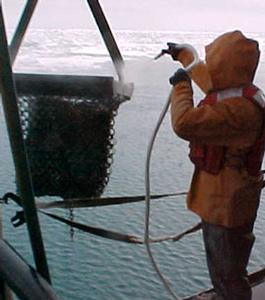31 March, 2001
Tidbit of History
Quasi War of 1798-1801 The original ten cutters placed into service in 1791
were soon replaced by larger ones. In 1798, the United States was without a
navy, the Continental Navy having been disbanded following the Revolutionary
War. Aggressive military and naval activity by France resulted in the
seizure of several merchant vessels by armed French vessels on the high
seas. The naval response of the United States was to employ the revenue
cutters in the defense of our merchant fleet. In these operations, the
cutters responded effectively, as they would in future conflicts in support
of the nation's naval missions. Especially outstanding were the Pickering,
Commodore Preble's first command, and the Eagle. The Eagle fought a
memorable engagement with the French privateer Revenge in 1799, recapturing
the American vessels Nancy and Mehitable.
Science Observations
We had an opportunity to practice using the HAPS multicorer today.
Throughout the trip a single core sample has been collected. The single
HAPS core goes into down three times. One core samples is sieved, and placed
in a container with formalin, sealed, and sent to the University of
Tennessee for further analysis. The remaining samples are used for
respiration experiments. Dr. Jackie Grebmeier designed the HAPS multicorer.
This piece of equipment is very similar to the HAPS core however, it is able
to gather four HAPS sediment samples with each drop. The University of
Tennessee machine shop constructed the piece of equipment. We had a perfect
day for launching the corer. The weather was not as cold and the ocean and
winds were calm.
We conducted two dredges. These dredges involved lowering a metal mesh like
bag by winch, over the side of the ship. The bag drags along the body of
the ocean floor collecting a deeper sediment sample, which contains a
variety of animals. Once it is lifted out of the ocean, it is sprayed with
water to release the sediment and the animals are collected and brought into
the wet lab for sorting and observation.
Daily Update
We completed two science stations today. We are able to do some extra
station work as a result of finishing the scheduled stations. We have
returned to some previous work areas to gather additional samples. It was
really nice being able to conduct some additional experiments with different
pieces of equipment.
The afternoon was spent preparing for my departure by helo to St. Lawrence
Island on Sunday. Laundry was finished, bags were packed and location for
delivery of each bag was determined.
Three Marine Mammal surveys were completed today, one in the morning and two
in the afternoon. These surveys will continue for several more days.

<> Dr. Grebmeier along with Polar Star Marine Science Technicians (MST) launch the HAPS multicorer.

<> The dredge is lifted out of the ocean and hosed down to release sediment. Boris Sirenko is holding the water hose.

<> The science group is busy sorting the contents collected from the dredge. This took several hours to complete.
Contact the TEA in the field at
.
If you cannot connect through your browser, copy the
TEA's e-mail address in the "To:" line of
your favorite e-mail package.
|
